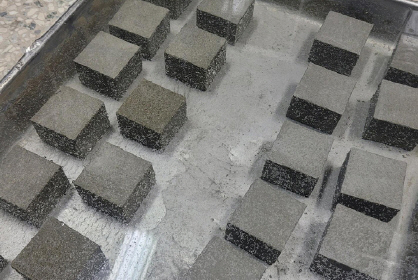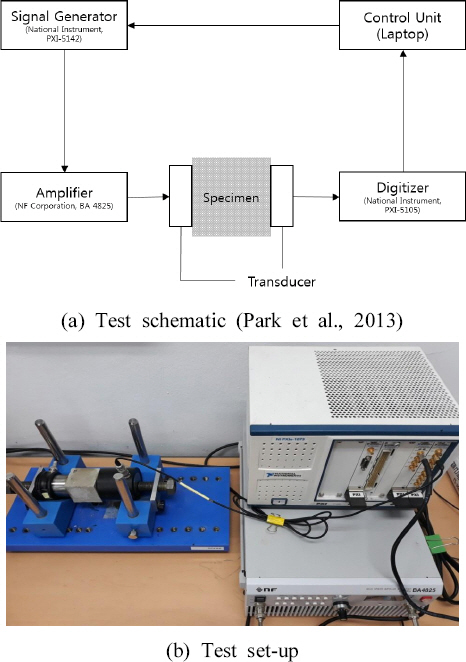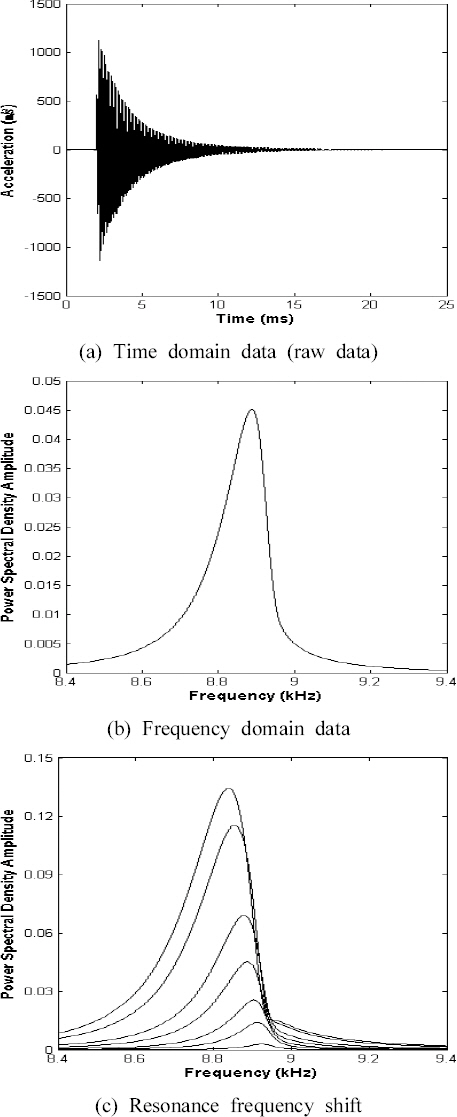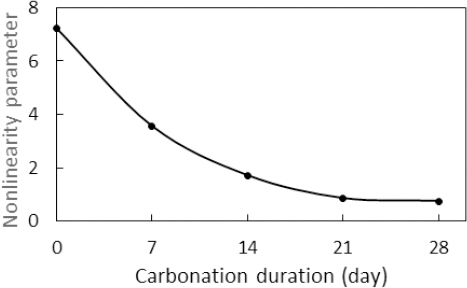 |
 |
- Search
| J. Korean Soc. Hazard Mitig. > Volume 23(1); 2023 > Article |
|
Abstract
Carbonation is a typical type of concrete deterioration that can cause various physicochemical changes and adversely affects the performance of reinforced concrete structures, particularly in offshore structures. Nonlinear resonant ultrasonic spectroscopy (NRUS), which is a non-destructive test technique, is applied in this study to experimentally evaluate the degree of concrete carbonation without damaging the structure. Nonlinearity parameters of test specimens exposed to accelerated carbonation conditions are measured via NRUS. The measured nonlinearity parameters indicate lower values for longer carbonation durations. This is because internal microcracks are reduced by CaCO3, which is a carbonation product. The consistent trend of the experimental results shows that NRUS can be effectively applied to evaluate concrete carbonation.
мҡ”м§Җ
мІ к·јмҪҳнҒ¬лҰ¬нҠё кө¬мЎ°л¬јмқҖ мӢңк°„м—җ л”°лҘё м—ҙнҷ”лЎң кө¬мЎ°м Ғ м„ұлҠҘмқҙ м Җн•ҳлҗҳлҠ”лҚ°, м—ҙнҷ” нҳ„мғҒ мӨ‘ н•ҳлӮҳмқё мҪҳнҒ¬лҰ¬нҠё нғ„мӮ°нҷ”лЎң мқён•ҙ н•ҙм–‘кө¬мЎ°л¬ј л“ұмқҳ лӮҙкө¬м„ұмқҙ м Җн•ҳлҗ мҲҳ мһҲлӢӨ. ліё м—°кө¬м—җм„ңлҠ” кө¬мЎ°л¬јм—җ мҶҗмғҒмқ„ мЈјм§Җ м•Ҡкі мҪҳнҒ¬лҰ¬нҠёмқҳ нғ„мӮ°нҷ” м •лҸ„лҘј мӢӨн—ҳм ҒмңјлЎң нҸүк°Җн•ҳкё° мң„н•ҙ 비нҢҢкҙҙ нҸүк°Җкё°лІ• мӨ‘ н•ҳлӮҳмқё л№„м„ нҳ• мҙҲмқҢнҢҢ кіө진기법мқ„ м Ғмҡ©н•ҳлҠ” л°©лІ•мқ„ мҶҢк°ңн•ҳкі мһҲлӢӨ. к°ҖмҶҚ нғ„мӮ°нҷ” мЎ°кұҙм—җ лҶ“мқё мӢңнҺём—җ л№„м„ нҳ• мҙҲмқҢнҢҢ кіө진기법мқ„ м Ғмҡ©н•ҙм„ң нғ„мӮ°нҷ” л…ём¶ңкё°к°„м—җ л”°лҘё л№„м„ нҳ•мқёмһҗлҘј мёЎм •н•ҳмҳҖлӢӨ. мёЎм •лҗң л№„м„ нҳ•мқёмһҗлҠ” нғ„мӮ°нҷ” л…ём¶ңкё°к°„мқҙ кёҙ мӢңнҺёмқјмҲҳлЎқ мһ‘мқҖ к°’мқ„ ліҙмқҙлҠ”лҚ°, мқҙлҠ” нғ„мӮ°нҷ”к°Җ 진н–үлҗ мҲҳлЎқ нғ„мӮ°нҷ” мғқм„ұл¬јмқё нғ„мӮ°м№јмҠҳм—җ мқҳн•ҙ лӮҙл¶Җ лҜём„ёк· м—ҙмқҙ к°җмҶҢн•ҳм—¬ мһ¬лЈҢм Ғ л№„м„ нҳ•м„ұмқҙ мӨ„м–ҙл“Өкё° л•Ңл¬ёмқҙлӢӨ. мқҙмІҳлҹј нғ„мӮ°нҷ” л…ём¶ң кё°к°„м—җ л”°лҘё л№„м„ нҳ•мқёмһҗмқҳ мқјкҙҖм„ұ мһҲлҠ” кі„мёЎ кІ°кіјлҠ” мҪҳнҒ¬лҰ¬нҠёмқҳ нғ„мӮ°нҷ”лҘј нҸүк°Җн•ҳлҠ”лҚ° л№„м„ нҳ• мҙҲмқҢнҢҢ кіө진기법мқ„ мң нҡЁн•ҳкІҢ м Ғмҡ©н• мҲҳ мһҲмқҢмқ„ ліҙм—¬мӨҖлӢӨ.
нҳ„лҢҖ кұҙм„Өкө¬мЎ°л¬јм—җ к°ҖмһҘ л§Һмқҙ м“°мқҙлҠ” нҳ•нғң мӨ‘ н•ҳлӮҳмқё мІ к·јмҪҳнҒ¬лҰ¬нҠё(reinforced concrete, RC)лҠ” мөңк·ј кө¬мЎ°л¬јмқҳ мӮ¬мҡ© м—°н•ңмқҙ лҠҳм–ҙк°җм—җ л”°лқј кө¬мЎ°л¬јмқҳ л…ём¶ң нҷҳкІҪм—җ л”°лҘё мҪҳнҒ¬лҰ¬нҠёмқҳ мҶҗмғҒ нҸүк°Җк°Җ м•Ҳм „м—җ мҳҒн–Ҙмқ„ лҜём№ҳлҠ” мӨ‘мҡ”н•ң мҡ”мҶҢлЎң м—¬кІЁм§Җкі мһҲлӢӨ. нҠ№нһҲ мөңк·ј к·ё кҙҖмӢ¬кіј мӨ‘мҡ”лҸ„к°Җ лҶ’м•„м§Җкі мһҲлҠ” н•ҙм–‘кө¬мЎ°л¬јм—җм„ңлҠ” мӢңк°„м—җ л”°лҘё мҪҳнҒ¬лҰ¬нҠё м—ҙнҷ”мқҳ лҢҖн‘ңм Ғмқё нҳ„мғҒмқё нғ„мӮ°нҷ”(Carbonation)к°Җ м „мІҙ кө¬мЎ°л¬јмқҳ м•Ҳм „м—җ м№ҳлӘ…м Ғмқё мң„нҳ‘мқҙ лҗ к°ҖлҠҘм„ұмқҙ нҒ¬лӢӨ(Im et al., 2004). мқҙмӮ°нҷ”нғ„мҶҢ(CO2)к°Җ мҪҳнҒ¬лҰ¬нҠё лӮҙл¶Җмқҳ мҲҳмӮ°нҷ”м№јмҠҳ(Ca(OH)2)мқҙлӮҳ calcium-silicate- hydrate (C-S-H)мҷҖ л°ҳмқ‘н•ҳм—¬ м•Ҳм •лҗң нғ„мӮ°м№јмҠҳ(CaCO3)мңјлЎң ліҖн•ҳл ӨлҠ” м„ұм§Ҳмқ„ нғ„мӮ°нҷ”лқјкі н•ҳл©°, мқҙлҹ¬н•ң нғ„мӮ°нҷ”лЎң мқён•ҙ мҪҳнҒ¬лҰ¬нҠёлҠ” нҷ”н•ҷм Ғ, кё°кі„м Ғ м„ұм§Ҳ л°Ҹ лҜём„ёкө¬мЎ°к°Җ ліҖнҷ”н•ңлӢӨ(Fabbri et al., 2009). нғ„мӮ°нҷ”мқҳ кІ°кіјлЎң мҪҳнҒ¬лҰ¬нҠёмқҳ м„ёкіөмқҙ мұ„мӣҢм ём„ң к°•лҸ„к°Җ мғҒмҠ№н•ҳлҠ” кІҪн–ҘлҸ„ мһҲмңјлӮҳ(Ho et al., 2018), мқјл°ҳм ҒмңјлЎң 12.5 м •лҸ„мқҳ к°’мқ„ ліҙмқҙлҠ” мҪҳнҒ¬лҰ¬нҠёмқҳ м•Ңм№јлҰ¬лҸ„к°Җ 9 мқҙн•ҳлЎң лӮ®м•„м§ҖкІҢ лҗҳл©ҙм„ң мһҘкё°м ҒмңјлЎң мІ к·јмҪҳнҒ¬лҰ¬нҠё кө¬мЎ° лӮҙл¶Җ мІ к·јмқҳ л¶ҖлҸҷн”јл§үмқ„ нҢҢкҙҙн•ҳм—¬ мІ к·ј л¶ҖмӢқмқ„ мқјмңјмјң м „мІҙ кө¬мЎ°л¬ј лӮҙкө¬м„ұ м Җн•ҳмқҳ мӣҗмқёмқҙ лҗңлӢӨ(Chang, 2017).
мҪҳнҒ¬лҰ¬нҠёмқҳ нғ„мӮ°нҷ”лҘј нҸүк°Җн•ҳкё° мң„н•ң л°©лІ•мңјлЎң нҺҳлҶҖн”„нғҲл Ҳмқё(phenolphthalein) м§ҖмӢңм•Ҫ, м—ҙмӨ‘лҹү분м„қ(thermogravimetric analysis, TGA), Xм„ нҡҢм Ҳ(X-ray diffraction, XRD) л“ұмқ„ мқҙмҡ©н•ҙ мӢңнҺё лӮҙ нҷ”н•©л¬јмқҳ лҶҚлҸ„лҘј м§Ғм ‘м ҒмңјлЎң мёЎм •н•ҳлҠ” л°©лІ•мқ„ л§Һмқҙ м Ғмҡ©н•ҙмҷ”лӢӨ(Chang and Chen, 2006). н•ҳм§Җл§Ң мң„мқҳ л°©лІ•л“Өмқ„ м Ғмҡ©н•ҙм„ң нғ„мӮ°нҷ”лҘј нҸүк°Җн•ҳкё° мң„н•ҙм„ңлҠ” нғ„мӮ°нҷ” мҳҲмёЎ к№Ҡмқҙ лҳҗлҠ” к·ё мқҙмғҒк№Ңм§Җ кө¬мЎ°л¬јм—җ мІңкіөмқ„ н•ҳкұ°лӮҳ мӢңнҺёмқ„ мұ„м·Ён•ҙм•ј н•ңлӢӨ. л”°лқјм„ң кё°ліём ҒмңјлЎң нҸүк°Җ лҢҖмғҒ кө¬мЎ°л¬јм—җ мҶҗмғҒмқ„ к°Җн•ҙм•ј н•ҳлҠ” л°©лІ•мқҙлҜҖлЎң лӘ…нҷ•н•ң н•ңкі„к°Җ мһҲлӢӨ. мқҙлҹ¬н•ң н•ңкі„лҘј к·№ліөн•ҳкё° мң„н•ҙ мҪҳнҒ¬лҰ¬нҠёмқҳ мғҒнғңлҘј нҸүк°Җн•ҳкё° мң„н•ң лӢӨм–‘н•ң 비нҢҢкҙҙ нҸүк°Җ кё°лІ•л“Өмқҙ м ңмӢңлҗҳм–ҙ мһҲмңјл©°, к·ё мӨ‘м—җм„ңлҸ„ мҙҲмқҢнҢҢлӮҳ нғ„м„ұнҢҢлҘј мқҙмҡ©н•ҳлҠ” мёЎм •кё°лІ•мқҙ л§ҺмқҖ м—°кө¬мһҗл“Өм—җ мқҳн•ҙ м—°кө¬лҗҳкі мһҲлӢӨ(Kim et al., 2010; Yim, Kwak et al., 2012). лӢӨл§Ң, м„ нҳ• мҙҲмқҢнҢҢлҘј мқҙмҡ©н•ң 비нҢҢкҙҙ нҸүк°Җ кё°лІ•мқҖ кұ°мӢңкІ°н•ЁмқҖ лҜјк°җн•ҳкІҢ мёЎм •мқҙ к°ҖлҠҘн•ҳм§Җл§Ң, м—ҙнҷ”лӮҳ лҜём„ёк· м—ҙ л“ұм—җ лҢҖн•ҙм„ңлҠ” мҳҲлҜјн•ҳкІҢ нҸүк°Җн•ҳм§Җ лӘ»н•ҙ нғ„мӮ°нҷ” нҸүк°Җм—җлҠ” л¶Җм Ғн•©н•ң мёЎл©ҙмқҙ мһҲлӢӨ.
ліё м—°кө¬м—җм„ңлҠ” мҪҳнҒ¬лҰ¬нҠёмқҳ нғ„мӮ°нҷ”лҘј нҸүк°Җн•ҳкё° мң„н•ҙ 비нҢҢкҙҙ нҸүк°Җ кё°лІ• мӨ‘ лҜём„ёмҶҗмғҒмқ„ лҜјк°җн•ҳкІҢ мёЎм •н• мҲҳ мһҲлҠ” л№„м„ нҳ• мҙҲмқҢнҢҢ кіө진기법(nonlinear resonant ultrasonic spectroscopy, NRUS)мқ„ мқҙмҡ©н•ҳмҳҖлӢӨ. лӢЁмқј мҙҲмқҢнҢҢлҘј мӮ¬мҡ©н•ҙ мқҙм—җ л”°лқј л°ңмғқн•ҳлҠ” кіө진 мЈјнҢҢмҲҳмқҳ ліҖнҷ”, 진нҸӯм—җ л”°лҘё к°җмҮ лҹү л“ұмқ„ мёЎм •н•ҳлҠ” л№„м„ нҳ• мҙҲмқҢнҢҢ кіө진기법мқҖ мһ¬лЈҢм Ғ л№„м„ нҳ•м„ұмқҙ лҶ’мқҖ м—ҙнҷ”лҗң мҪҳнҒ¬лҰ¬нҠёмқҳ к°•лҸ„ нҸүк°Җ л“ұм—җ л§Һмқҙ м Ғмҡ©лҗҳкі мһҲлӢӨ(Bouchaala et al., 2011). мӢӨн—ҳмқ„ нҶөн•ҙ м„ңлЎң лӢӨлҘё нҷҳкІҪм—җ л…ём¶ңлҗң мӢңл©ҳнҠё нҺҳмқҙмҠӨнҠё мӢңнҺёмқҳ нғ„мӮ°нҷ” м •лҸ„лҘј л№„м„ нҳ• мҙҲмқҢнҢҢ кіө진 кё°лІ•мқ„ мқҙмҡ©н•ҳм—¬ нҸүк°Җн•ҳкі , нҸүк°Җ кІ°кіј м–»м–ҙм§ҖлҠ” л№„м„ нҳ• мқёмһҗлҘј 비көҗн•ҳм—¬ мҪҳнҒ¬лҰ¬нҠё нғ„мӮ°нҷ”м—җ лҢҖн•ң 비нҢҢкҙҙ кІҖмӮ¬ кё°лІ•мқҳ нҷңмҡ©м„ұмқ„ нҷ•мқён•ҳмҳҖлӢӨ.
мҪҳнҒ¬лҰ¬нҠё нғ„мӮ°нҷ” мӨ‘ мҲҳмӮ°нҷ”м№јмҠҳ(Ca(OH)2)кіј мқҙмӮ°нҷ”нғ„мҶҢ(CO2)м—җ мқҳн•ң л°ҳмқ‘мқҖ Eq. (1)кіј к°ҷмқҙ лӮҳнғҖлӮј мҲҳ мһҲлӢӨ.
мқҙ л°ҳмқ‘мңјлЎң мҪҳнҒ¬лҰ¬нҠё лӮҙл¶Җмқҳ мҲҳмӮ°нҷ”м№јмҠҳмқҙ к°җмҶҢн•ҳм—¬ мҪҳнҒ¬лҰ¬нҠёмқҳ м•Ңм№јлҰ¬лҸ„к°Җ лӮ®м•„м§Җкё°лҸ„ н•ҳм§Җл§Ң л°ҳмқ‘мқҳ кІ°кіјлЎң мғқм„ұлҗң нғ„мӮ°м№јмҠҳ(CaCO3)мңјлЎң мқён•ҙ мҪҳнҒ¬лҰ¬нҠёмқҳ м„ёкіөмқҙ мұ„мӣҢм§Җл©ҙм„ң мҪҳнҒ¬лҰ¬нҠёк°Җ к°Җм§ҖлҠ” мһ¬лЈҢм Ғ л№„м„ нҳ•м„ұмқҙ мӨ„м–ҙл“ңлҠ” м—ӯн• мқ„ н•ҳкё°лҸ„ н•ңлӢӨ. мЈјмҡ” кіЁмһ¬л“Өмқҙ л°”мқёлҚ”(cement paste)лЎң кІ°н•©лҗҳм–ҙ мһҲлҠ” мҪҳнҒ¬лҰ¬нҠёмқҳ нҠ№м„ұмғҒ, лӮҙл¶Җ кө¬м„ұмһ¬лЈҢ мӮ¬мқҙм—җлҠ” лҜём„ёк· м—ҙмқҙ л§Һмқҙ л°ңмғқн•ҳлҠ”лҚ°, нғ„мӮ°нҷ” мғқм„ұл¬јмқё нғ„мӮ°м№јмҠҳмқҙ л°ҳмқ‘л¬јмқё мҲҳмӮ°нҷ”м№јмҠҳліҙлӢӨ лӘ° л¶Җн”јк°Җ м»Өм„ң мҪҳнҒ¬лҰ¬нҠё лӮҙл¶Җ лҜём„ёкіөк·№ к°җмҶҢнҡЁкіјк°Җ мһҲлӢӨ.
нғ„м„ұмІҙмқҳ л№„м„ нҳ• мқ‘л Ҙ-ліҖнҳ•лҘ кҙҖкі„лҠ” мқјл°ҳм ҒмңјлЎң Eq. (2)мҷҖ к°ҷмқҙ лӮҳнғҖлӮј мҲҳ мһҲлӢӨ.
мқҙ л•Ң, ПғлҠ” мқ‘л Ҙ, ОөмқҖ ліҖнҳ•лҘ , K0лҠ” м„ нҳ•нғ„м„ұкі„мҲҳ, к·ёлҰ¬кі ОІмҷҖ ОҙлҠ” н…Ңмқјлҹ¬кёүмҲҳм „к°ңлҘј нҶөн•ҙ м–»м–ҙ진 кі„мҲҳмқҙл©°, ліҖнҳ•лҘ мқҳ м ңкіұн•ӯ(ОҙОө2)л¶Җн„°лҠ” л§Өмҡ° мһ‘мқҖ к°’мқ„ ліҙмқҙлҜҖлЎң л¬ҙмӢңн• мҲҳ мһҲлӢӨ. мҪҳнҒ¬лҰ¬нҠёмҷҖ к°ҷмқҖ NME (nonlinear mesoscopic elastic) мһ¬лЈҢлҠ” ліҖнҳ•лҘ кіј ліҖнҳ•лҘ мҶҚлҸ„м—җ л”°лқј нғ„м„ұкі„мҲҳк°Җ ліҖн•ҳлҠ” л№„м„ нҳ•м Ғ мқҙл ҘнҡЁкіјлҘј лӮҳнғҖлӮҙкІҢ лҗҳлҠ”лҚ°, мқҙлҹ¬н•ң мһ¬лЈҢмқҳ мқ‘л Ҙ-ліҖнҳ•лҘ кҙҖкі„лҘј нҢҢлҸҷл°©м •мӢқмңјлЎңл¶Җн„° м •лҰ¬н•ҳл©ҙ Eqs. (3), (4)мҷҖ к°ҷлӢӨ(Van Den Abeele et al., 2000).
мқҙ мӢқм—җм„ң, ОұлҠ” мқҙл Ҙнҳ„мғҒм—җ лҢҖн•ң л№„м„ нҳ•мқёмһҗ, О”ОөмқҖ мқҙм „ мЈјкё°м—җм„ң л°ңмғқн•ң ліҖнҳ•лҘ мқҳ 진нҸӯліҖнҷ”, ОөЛҷлҠ” ліҖнҳ•лҘ мҶҚлҸ„мқҙл©°, ліҖнҳ•лҘ мқҳ л¶ҖнҳёлҘј лӮҳнғҖлӮҙкё° мң„н•ҙ ОөЛҷк°Җ 0ліҙлӢӨ нҒ¬л©ҙ sign(ОөЛҷ)=1, 0ліҙлӢӨ мһ‘мңјл©ҙ sign(ОөЛҷ)=-1мқҙлӢӨ.
мһ¬лЈҢмқҳ л№„м„ нҳ•м Ғ мқҙл Ҙнҳ„мғҒмқҖ ліҖнҳ•лҘ мқҳ 진нҸӯліҖнҷ”(О”Оө)м—җ л”°лҘё мӢңнҺёмқҳ кіө진주нҢҢмҲҳ ліҖнҷ”лҘј л°ңмғқмӢңнӮӨлҠ”лҚ°, кіө진주нҢҢмҲҳ мІңмқҙлқјкі л¶ҲлҰ¬лҠ” мқҙ кіө진 мЈјнҢҢмҲҳмқҳ ліҖнҷ”лҠ” Eq. (5)мқҳ кҙҖкі„лҘј л”°лҘёлӢӨ(Van Den Abeele et al., 2000).
м—¬кё°м„ң f0лҠ” кіө진주нҢҢмҲҳмқҳ мҙҲкё°к°’, fлҠ” 충격м—җл„Ҳм§Җмқҳ ліҖнҷ”м—җ л”°лқј мёЎм •лҗң кіө진주нҢҢмҲҳмқҙлӢӨ. мқјл°ҳм ҒмңјлЎң мҪҳнҒ¬лҰ¬нҠё лӮҙл¶Җ лҜём„ёмҶҗмғҒмқҙ мҰқк°Җн•ҳл©ҙ мҪҳнҒ¬лҰ¬нҠёмқҳ мқҙл Ҙнҳ„мғҒмқҙ м җм°Ё мӢ¬нҷ”лҗҳм–ҙ л№„м„ нҳ•мқёмһҗ(Оұ)к°Җ м»Өм§ҖкІҢ лҗңлӢӨ(Yim, Kim et al., 2012). мҪҳнҒ¬лҰ¬нҠё нғ„мӮ°нҷ”мқҳ кІҪмҡ°, нғ„мӮ°нҷ”мқҳ 진н–үм—җ л”°лқј лӮҙл¶Җ лҜём„ёкіөк·№мқҙ к°җмҶҢн•ҳлҠ” кІҪн–Ҙмқ„ ліҙмқҙкІҢ лҗ кІғмқҙлҜҖлЎң нғ„мӮ°нҷ”м •лҸ„к°Җ нҒҙмҲҳлЎқ л№„м„ нҳ•мқёмһҗк°Җ к°җмҶҢн• кІғмңјлЎң мҳҲмғҒлҗңлӢӨ.
нғ„мӮ°нҷ” 진н–үм—җ лҢҖн•ң л¶Ҳнҷ•мӢӨм„ұмқ„ мӨ„мқҙкё° мң„н•ҙ кіЁмһ¬к°Җ л“Өм–ҙмһҲм§Җ м•ҠмқҖ мӢңл©ҳнҠё нҺҳмқҙмҠӨнҠёлЎң мӢңнҺёмқ„ м ңмһ‘н–ҲлӢӨ. 50 Г— 50 Г— 50 mmмқҳ м •мңЎл©ҙмІҙмқҳ мӢңнҺёмқ„(Fig. 1), л…ём¶ң нҷҳкІҪ лі„лЎң 3к°ңм”© мӨҖ비н•ҳм—¬ мӢӨн—ҳмғҒ л°ңмғқн• мҲҳ мһҲлҠ” мҳӨм°ЁлҘј мӨ„мқҙкі мһҗ н•ҳмҳҖлӢӨ. кё°мЎҙ м—°кө¬м—җ л”°лҘҙл©ҙ нғ„мӮ°нҷ” м •лҸ„лҠ” л¬ј-мӢңл©ҳнҠёл№„, м–‘мғқмЎ°кұҙ, мқҙмӮ°нҷ”нғ„мҶҢ л…ём¶ңмӢңк°„ л“ұм—җ мҳҒн–Ҙмқ„ л°ӣлҠ”лӢӨ(Papadakis et al., 1991). ліё м—°кө¬м—җм„ңлҠ” к°Ғ мӢңнҺёмқҳ нғ„мӮ°нҷ” м •лҸ„лҘј нҡЁмңЁм ҒмңјлЎң м ңм–ҙн•ҳкё° мң„н•ҙ, лҸҷмқјн•ң л¬ј-мӢңл©ҳнҠёл№„(W/C = 0.6)мҷҖ м–‘мғқмЎ°кұҙ(мҲҳмӨ‘м–‘мғқ 7мқј, мҳЁлҸ„ 50 в„ғ)мқ„ м Ғмҡ©н•ҳмҳҖлӢӨ. м–‘мғқмқҙ лҒқлӮң нӣ„, мӢңнҺёмқҖ кё°мҳЁ 25 в„ғ, мғҒлҢҖмҠөлҸ„ 65%, мқҙмӮ°нҷ”нғ„мҶҢ лҶҚлҸ„ 10% vol.мқҳ мқјм •н•ң мЎ°кұҙм—җ л…ём¶ңлҗҳм—ҲлӢӨ. м–‘мғқмҳЁлҸ„мҷҖ к°ҖмҶҚ мқҙмӮ°нҷ”нғ„мҶҢ мЎ°кұҙм—җм„ңмқҳ мҳЁлҸ„ м°Ёмқҙм—җ мқҳн•ҙ 추к°Җм Ғмқё мҲҳнҷ”л°ҳмқ‘мқҙ л°ңмғқн•ҳм§Җ м•Ҡмқ„ кІғмңјлЎң нҢҗлӢЁлҗҳм–ҙ(Hwang et al., 2002), мҲҳнҷ”л°ҳмқ‘м—җ мқҳн•ң кіөк·№к°җмҶҢлҠ” ліё м—°кө¬м—җм„ңлҠ” кі л Өн•ҳм§Җ м•Ҡм•ҳлӢӨ. нғ„мӮ°нҷ” л…ём¶ң кё°к°„мқ„ 0мқјл¶Җн„° 28мқјк№Ңм§Җ 7мқј к°„кІ©мңјлЎң лӢ¬лҰ¬н•ҳмҳҖмңјл©°, к°Ғк°Ғмқҳ кІҪмҡ°м—җ лҢҖн•ҙ л№„м„ нҳ•мқёмһҗлҘј кі„мёЎн•ҳкё° мң„н•ҙ нғ„мӮ°нҷ” л…ём¶ң мў…лЈҢ м§Ғнӣ„ л№„м„ нҳ• мҙҲмқҢнҢҢ кіө진기법мқ„ м Ғмҡ©н•ҳмҳҖлӢӨ.
л№„м„ нҳ•мқёмһҗлҘј мёЎм •н•ҳкё° мң„н•ң мӢӨн—ҳмһҘм№ҳмқҳ кө¬м„ұкіј мёЎм •кІ°кіјлҠ” Figs. 2 л°Ҹ 3кіј к°ҷлӢӨ(Park et al., 2013). 충격 к°Җ진мқ„ нҶөн•ҙ мӢңнҺёмқҳ кіө진мқ„ мң л°ңмӢңнӮӨкі , мІ« лІҲм§ё 압축 кіө진лӘЁл“ңм—җ лҢҖн•ҙм„ң мЈјнҢҢмҲҳлҘј мёЎм •н–ҲлӢӨ. мқҙ л•Ң, к°Җн•ҙ진 충격 м—җл„Ҳм§ҖлҘј лӢ¬лҰ¬н•ҳм—¬ кіө진주нҢҢмҲҳмқҳ ліҖнҷ”лҘј л°ңмғқмӢңнӮӨл©ҙ Eq. (5)м—җ л”°лқј кіө진주нҢҢмҲҳ мІңмқҙк°’мқ„ кі„мӮ°н• мҲҳ мһҲкі , мһ…мӮ¬нҢҢмқҳ 진нҸӯліҖнҷ”лҘј мқҙмҡ©н•ҳл©ҙ мөңмў…м ҒмңјлЎң к°Ғ мӢңнҺёлі„ л№„м„ нҳ• мқёмһҗлҘј мёЎм •н• мҲҳ мһҲлӢӨ. мһ…мӮ¬нҢҢлҠ” 7 Vл¶Җн„° 11 Vк№Ңм§Җмқҳ мӢ нҳёлҘј 0.25 V лӢЁмң„лЎң мҰқк°ҖмӢңмјңк°Җл©° мҙқ 17к°ңлҘј мғқм„ұн•ҳмҳҖлӢӨ. кіө진주нҢҢмҲҳмқҳ мҙҲкё°к°’(f0)мқҖ к°Ғ л…ём¶ң мЎ°кұҙ лі„лЎң м–»м–ҙ진 кіө진주нҢҢмҲҳ лҚ°мқҙн„°м—җ м„ нҳ•нҡҢк·Җ분м„қмқ„ м Ғмҡ©н•ҳм—¬ м–»м–ҙ진 축мқҳ м ҲнҺё к°’мңјлЎң к°Җм •н–ҲлӢӨ.
к°Ғ мһ…мӮ¬нҢҢ лі„лЎң мёЎм •лҗң PSD (power spectral density, V2/Hz)мқҳ мөңлҢҖк°’м—җ лҢҖн•ҙ кі„мӮ°лҗң кіө진주нҢҢмҲҳ мІңмқҙк°’мқ„ Fig. 4м—җ лӮҳнғҖлӮҙм—ҲлӢӨ. нғ„мӮ°нҷ” л…ём¶ң кё°к°„м—җ л”°лқј к°Ғк°Ғ м„ нҳ•нҡҢк·Җ분м„қмқ„ м Ғмҡ©н•ҳкі , м–»м–ҙ진 нҡҢк·Җ분м„қмӢқмқҳ кё°мҡёкё°лҘј мқҙмҡ©н•ҙм„ң к°Ғ нғ„мӮ°нҷ” мЎ°кұҙм—җ л”°лҘё л№„м„ нҳ•мқёмһҗлҘј кі„мӮ°н•ҳм—¬ Table 1кіј Fig. 5м—җ лӮҳнғҖлӮҙм—ҲлӢӨ.
Nonlinearity Parameters according to Carbonation Duration
нғ„мӮ°нҷ”к°Җ 진н–үлҗҳм§Җ м•ҠмқҖ мӢңнҺёмқҳ л№„м„ нҳ•мқёмһҗк°Җ к°ҖмһҘ нҒ° к°’мқ„ ліҙмҳҖмңјл©°, л…ём¶ңкё°к°„мқҙ кёём–ҙм§ҲмҲҳлЎқ л№„м„ нҳ•мқёмһҗк°Җ к°җмҶҢн•ҳлҠ” кІҪн–Ҙмқ„ лӮҳнғҖлӮёлӢӨ. мқҙлҠ” мҪҳнҒ¬лҰ¬нҠё нғ„мӮ°нҷ”мқҳ кІ°кіјлЎң мғқм„ұлҗң нғ„мӮ°м№јмҠҳмқҙ лҜём„ёкіөк·№мқ„ мұ„мӣҢ мһ¬лЈҢм Ғ л№„м„ нҳ•м„ұмқҙ к°җмҶҢн• кІғмқҙлқјлҠ” к°Җм„Өм—җ л¶Җн•©н•ҳлҠ” кІ°кіјмқҙлӢӨ. лӢӨл§Ң, л№„м„ нҳ•мқёмһҗмқҳ к°җмҶҢнҸӯмқҖ мІ« 7мқј лҸҷм•Ҳ к°ҖмһҘ нҒ° нҸӯмңјлЎң к°җмҶҢн–Ҳкі , л…ём¶ң кё°к°„мқҙ кёём–ҙм§ҲмҲҳлЎқ м җм°Ё мӨ„м–ҙл“ңлҠ” кІҪн–Ҙмқ„ ліҙмҳҖлӢӨ. нҠ№нһҲ л…ём¶ңкё°к°„ 21мқјкіј 28мқј мӮ¬мқҙм—җм„ңлҠ” л№„м„ нҳ•мқёмһҗк°Җ к°җмҶҢн•ҳкё°лҠ” н–ҲмңјлӮҳ к°җмҶҢнҸӯмқҙ көүмһҘнһҲ мһ‘мқҢмқ„ нҷ•мқён• мҲҳ мһҲлӢӨ. мқҙлҹ¬н•ң к°җмҶҢнҸӯмқҳ ліҖнҷ”лҠ” л‘җ к°Җм§Җ мёЎл©ҙм—җм„ң мӣҗмқёмқ„ м°ҫм•„ ліј мҲҳ мһҲкІ лҠ”лҚ°, лЁјм Җ мҪҳнҒ¬лҰ¬нҠё нғ„мӮ°нҷ” л°ҳмқ‘мқҙ л…ём¶ңмҙҲкё°м—җ л§Һмқҙ л°ңмғқн•ҳкі л…ём¶ңкё°к°„мқҙ кёём–ҙм§ҲмҲҳлЎқ м җм°Ё мӨ„м–ҙл“ лӢӨлҠ” м җмқҙлӢӨ. нғ„мӮ°нҷ”м—җ л”°лқј мҪҳнҒ¬лҰ¬нҠё лӮҙл¶Җ мҲҳмӮ°нҷ”м№јмҠҳмқҳ лҶҚлҸ„к°Җ мӨ„м–ҙл“Өл©ҙм„ң нғ„мӮ°нҷ” л°ҳмқ‘ мһҗмІҙк°Җ лҚң мқјм–ҙлӮҳкІҢ лҗҳлҠ” кІғмқҙлӢӨ. лӢӨлҘё мқҙмң лЎңлҠ” кіөк·№лҘ мқҳ ліҖнҷ”лҘј мғқк°Ғн•ҙліј мҲҳ мһҲмқ„ кІғмқҙлӢӨ. нғ„мӮ°нҷ”м—җ мқҳн•ҙ кіөк·№лҘ мқҙ мқјм • мҲҳмӨҖ мқҙн•ҳлЎң л–Ём–ҙм§ҖкІҢ лҗҳл©ҙ мҪҳнҒ¬лҰ¬нҠё лӮҙл¶Җм—җм„ң мқҙмӮ°нҷ”нғ„мҶҢ мқҙлҸҷмқҙ м–ҙл ӨмӣҢм§Җкі к·ёлЎң мқён•ҙ нғ„мӮ°нҷ” л°ҳмқ‘мқҙ мҙҲкё°м—җ 비н•ҙ мӨ„м–ҙл“ӨкІҢ лҗңлӢӨ.
мҪҳнҒ¬лҰ¬нҠё лӮҙл¶Җмқҳ нғ„мӮ°нҷ” м •лҸ„лҘј нҸүк°Җн•ҳкё° мң„н•ҙ к°ҖмҶҚ нғ„мӮ°нҷ” мЎ°кұҙм—җ лҶ“мқё мӢңл©ҳнҠё нҺҳмқҙмҠӨнҠё мӢңнҺём—җ 비нҢҢкҙҙ нҸүк°Җ кё°лІ• мӨ‘ н•ҳлӮҳмқё л№„м„ нҳ• мҙҲмқҢнҢҢ кіө진기법мқ„ м Ғмҡ©н–ҲлӢӨ. нғ„мӮ°нҷ” л…ём¶ңкё°к°„мқ„ лӢӨлҘҙкІҢ н•ң мӢңнҺё к°Ғк°Ғм—җ лҢҖн•ҙ л№„м„ нҳ•мқёмһҗлҘј кі„мёЎн•ҳкі , нғ„мӮ°нҷ” л…ём¶ңкё°к°„м—җ л”°лҘё л№„м„ нҳ•мқёмһҗмқҳ ліҖнҷ” кІҪн–Ҙмқ„ мӮҙнҺҙліҙм•ҳлӢӨ. мӢӨн—ҳмқ„ нҶөн•ҙ нғ„мӮ°нҷ” л…ём¶ңкё°к°„мқҙ кёём–ҙм§ҲмҲҳлЎқ л№„м„ нҳ•мқёмһҗк°Җ мһ‘아진лӢӨлҠ” кІғмқ„ ліј мҲҳ мһҲм—Ҳкі , мқҙлҠ” нғ„мӮ°нҷ” л°ҳмқ‘мқҳ кІ°кіјлЎң мғқм„ұлҗң нғ„мӮ°м№јмҠҳмңјлЎң мқён•ҙ лӮҙл¶Җкіөк·№мқҙ мұ„мӣҢм ё мҪҳнҒ¬лҰ¬нҠёмқҳ мһ¬лЈҢм Ғ л№„м„ нҳ•м„ұмқҙ к°җмҶҢн–Ҳкё° л•Ңл¬ёмқҙлқјкі 분м„қн• мҲҳ мһҲлӢӨ. ліё м—°кө¬мқҳ кІ°кіјлЎң мҪҳнҒ¬лҰ¬нҠё лӮҙл¶Җмқҳ нғ„мӮ°нҷ” м •лҸ„лҘј нҢҗлӢЁн•ҳлҠ” лҚ°м—җ л№„м„ нҳ• мҙҲмқҢнҢҢ кіө진기법мқ„ м Ғмҡ©н• мҲҳ мһҲлӢӨлҠ” кІғмқ„ нҷ•мқён• мҲҳ мһҲм—ҲлӢӨ. лӢӨл§Ң, мҪҳнҒ¬лҰ¬нҠё лӮҙл¶Җмқҳ м •нҷ•н•ң нғ„мӮ°нҷ” к№ҠмқҙлҘј л№„м„ нҳ• мҙҲмқҢнҢҢ кіө진기법мңјлЎң м¶”м •н•ҳкё° мң„н•ҙм„ңлҠ” л…ём¶ңкё°к°„м—җ л”°лқј л№„м„ нҳ•мқёмһҗмқҳ к°җмҶҢнҸӯмқҙ мӨ„м–ҙл“ңлҠ” л©”м»ӨлӢҲмҰҳмқҳ м •нҷ•н•ң к·ңлӘ…кіј нғ„мӮ°нҷ” к№ҠмқҙмҷҖ л№„м„ нҳ•мқёмһҗ мӮ¬мқҙмқҳ кҙҖкі„лҘј нҢҢм•…н•ҳлҠ” 추к°Җм Ғмқё м—°кө¬к°Җ н•„мҡ”н• кІғмңјлЎң нҢҗлӢЁлҗңлӢӨ.
References
1. Bouchaala, F, Payan, C, Garnier, V, and Balayssac, J.P (2011) Carbonation assessment in concrete by nonlinear ultrasound. Cement and Concrete Research, Vol. 41, No. 5, pp. 557-559.

2. Chang, C.F, and Chen, J.W (2006) The experimental investigation of concrete carbonation depth. Cem Concr Res, Vol. 36, No. 9, pp. 1760-1767.

3. Chang, H (2017) Chloride binding capacity of pastes influenced by carbonation under three conditions. Cem Concr Compos, Vol. 84, pp. 1-9.

4. Fabbri, A, Corvisier, J, Schubnel, A, Brunet, F, Goffe, B, Rimmele, G, and Barlet-Gouedard, V (2009) Effect of carbonation on the hydro-mechanical properties of Portland cements. Cement and Concrete Research, Vol. 39, No. 12, pp. 1156-1163.

5. Ho, L.S, Nakarai, K, Ogawa, Y, Sasaki, T, and Morioka, M (2018) Effect of internal water content on carbonation progress in cement-treated sand and effect of carbonation on com-pressive strength. Cem Concr Compos, Vol. 85, pp. 9-21.

6. Hwang, S.D, Lee, K.M, and Kim, J.K (2002) Strength estimation model of early-age concrete considering degree of hydration and porosity. Journal of the Korea Concrete Institute, Vol. 14, No. 2, pp. 137-147.

7. Im, J.S, Bahng, Y.S, and Jo, J.B (2004) A study on the cover property of offshore reinforced concrete structure. Journal of Korean Society of Hazard Mitigation, Vol. 4, No. 3, pp. 73-82.

8. Kim, J.H, Kwak, H.G, and Min, J (2010) Characterization of the crack depth in concrete using self-compensating frequency response function. NDT &E International, Vol. 43, No. 5, pp. 375-384.

9. Papadakis, V.G, Vayenas, C.G, and Fardis, M.N (1991) Fundamental modeling and experimental investigation of concrete carbonation. Materials Journal, Vol. 88, No. 4, pp. 363-373.

10. Park, S.J, Yim, H.J, and Kwak, H.G (2013) Evaluation of thermal damage of concrete using nonlinear resonance characteristic. 2013 Spring conference of Korea Institute For Structural Maintenance and Ispection.

11. Van Den Abeele, K.A, Johnson, P.A, and Sutin, A (2000) Nonlinear elastic wave spectroscopy (NEWS) techniques to discern material damage, Part I:Nonlinear wave modulation spectroscopy (NWMS). Journal of Research in Nondestructive Evaluation, Vol. 12, No. 1, pp. 17-30.












